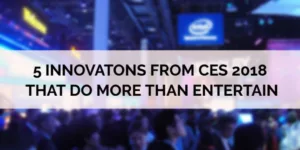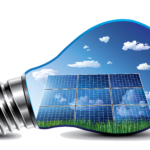Among the giant 146-inch TVs and talking microwaves at CES 2018, there were a number of technical innovations that provide much more than entertainment.
We take a look at 5 tech devices that have the potential to improve our health, save natural resources and even prevent cancer.
1) Microsoft Hololens.
Six years ago, Microsoft showcased Kinect at CES 2012 to much fanfare and expectation. Sadly, the console didn’t live up to it’s early hype and Microsoft stopped manufacturing the unit this past fall.
From the Kinects ashes rises the Microsoft Hololens, augmented reality smartglasses which run on Microsoft’s mixed-reality platform.
You may be thinking this sounds a lot like Google’s ill-fated Google Glass, and combining two failed concepts together seems an unlikely recipe for success. However, there are plenty of signs that history won’t be repeated with the Hololens.
Microsoft have a number of exiting use cases which could have a disruptive impact on different industries and benefit society as a whole. And when you consider the AR industry is forecasted to be worth $90 billion in 2020, it’s worth taking a gamble on.
One of these is a partnership with Case Western Reserve University to use 3-D images to help surgeons and also train medical students. Another is with NASA’s Jet Propulsion Lab to help scientists simulate conditions on Mars.
Boeing have also been using the Hololens in combination with their drones to fight fires. The drone sends digital images back to the headset, give a 3-D view to a fire-chief on the ground.
When you also consider opportunities that could exist in car manufacture, architecture, construction and professional training, it seems likely that Microsoft have finally backed a winner.
2) L’oreal UV Sense.
You might not expect a cosmetics company to launch a tech device which prevents cancer, but that’s exactly what L’Oreal have done with UV sense.
The miniature device which measures just 9mm long and 2 mm thick is placed on the wearers thumbnail to monitor their amount of UV exposure. This may seem strange, but L’Oreal believe this is a part of the body that receives optimal sunlight for receiving data.
The device uses Near Field Communication (NFC) to connect to an App which warns users when they need to get into some shade.
By storing a users exposure to sunlight, L’Oreals wearable tech could also help prevent vitamin D deficiency,
Vitamin D deficiency leads to a number of symptoms including tiredness, depression and muscle and bone pain.
The American Journal of Clinical Nutrition recently estimated 10% of U.S adults are Vitamin D deficient. It’s also on the rise in children who are increasingly spending more time inside.
It’s great to see L’Oreal taking the initiative here with a product that could benefit us all.
3) Waterless Washing Machines & Smart Faucets.
As we move into the next decade, water conservation will surely become a pressing issue, and of course if you live in California it has been for many years already.
Laundry accounts for 15% of our total water usage so improved washing machine designs could potentially save millions of gallons a year.
British company Xeros showcased their “Waterless” Washing Machines at this years CES, leading some industry observers to label it the future of washing machines.
The Xeros design uses 80% less water that regular washing machines to launder clothes. It does this by harnessing the power of recyclable plastic beads.
You might think this would reduce cleaning performance, but the company believes the beads are that effective you no longer need to pre-wash stained clothes.
The hotel industry is particularly interested in this tech as they use massive amounts of energy to launder towels and linen every day. At the moment, having a “Waterless” washing machine in every home still seems some way off.
One smart innovation which has already hit the stores is Kohler’s Sensate Touchless Faucet.
The touchless faucet runs on Kohler’s new “Konnect” platform, which uses Microsoft’s Azure IOT solutions.
The faucet is activated by voice commands or by its high-tech motion sensor which responds in just 20 milliseconds It can also dispense pre-set amounts of water, such as when filling an 8oz cup or a pot with water.
The Sensate monitors water usage and makes the data available through Kohler’s Konnect app, too
Hopefully they’ll be more technical innovations to help conserve water over the coming years.
4) Philips Smartsleep Tracker.
Tech gadgets are constantly being blamed for causing people to not sleep enough, so it seems ironic that one could help solve the problem.
Philips Smartsleep Tracker was on display at CES 2018 and it’s a device which aims to help people sleep better.
The tracker is basically a headband which uses forehead sensors to monitor brain activity. Once deep sleep is detected, speaker on the head play white noise. It’s believed that this will keep you in the zone for longer.
Philips say that 70% of trial subjects reported an improvement in their quality of sleep. However, quite a few tech bloggers have commented on the unappealing look of the design.
I’m sure this won’t be a major concern to the millions of insomnia sufferers trying to make it through another day in the office. And it will still look better than starting a fight club.
5) Ergo IQ Workstation Tech.
We might spend 1/3 of our lives sleeping (if we’re lucky) but many people spend another third sat at a desk.
The human body wasn’t designed for sitting for long periods and numerous health problems (not to mention weight gain) occur as a result. One company using tech to improve the situation is New York City’s Humanscale.
Humanscale are a company which specialize in designing and manufacturing ergonomic products for workspaces.
The company showcased their “Office IQ” device at CES 2018. The Office IQ is a sensor box which monitors employees use of workstations.
A number of key metrics are recorded such as total standing or sitting time and the amount of calories burned. The device also sounds an alarm when users have been sitting for too long.
The cool thing about Office IQ is that it’s been gamified, so different departments can choose to compete against each other based on their movement metrics. That’s a really great way to help people commit to staying healthy.
Some users have taken to calling it “Fitbit for the office” and I’m sure Homescale hope for similar success.








